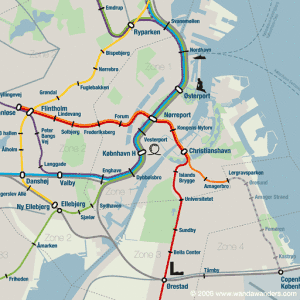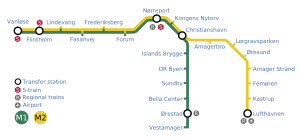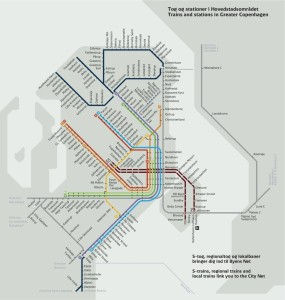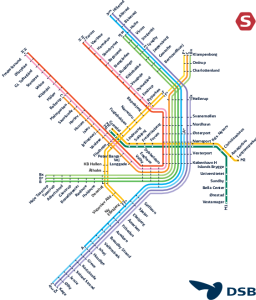Copenhagen metro, also known as “Københavns Metro” o “S-tog”, is the underground and surface transportation system that operates in the capital of Denmark, in Europe.
Inaugurated on 19 October 2002, has expanded over the years with its latest expansion carried out in 2007. At the moment, the system covers 170 kilometres (about 105.63 miles), con 84 stations that cover both the city center and peripheral areas.
Here's the Copenhagen metro map:
Copenhagen Metro timetables
The metro operates with the following schedules:
- Every day: continuous service 24 hours with different frequencies.
Rates
The Copenhagen Metro uses a zone-based fare system, which also extends to the rest of the public transport network of the capital region. The city is divided into several zones, and the cost of the tickets varies depending on how many areas the trip covers.
- One-way ticket: Cuesta 24 DKK (~3,50 USD) for a trip covering two areas, the minimum available rate. Each single ticket is valid for 1 hour from purchase and can be used on buses, trains and subways within the covered areas.
- Bill of 24 Hours: Offers unlimited travel within all areas of Copenhagen during 24 hours per 160 DKK (~23,50 USD). Ideal for tourists and those who plan to travel through different parts of the city in a single day.
- City Pass: Available in versions for 24, 48, 72, 96 y 120 hours, This pass covers unlimited travel in the zones 1-4 (which include the airport) during the validity period. Prices vary between 80 DKK (~11,75 USD) for 24 hours, until 300 DKK (~44 USD) for the pass of 120 hours.
- Tarjeta Travel card: A reloadable card that offers lower rates and flexibility. Travelers can charge balance and pay only for the areas traveled. It is a popular choice for residents and frequent travelers.
- Discount and Family Tickets: Children under 12 years old travel free with an adult who has a valid ticket. Besides, there are discounts for students and seniors.
Official Web site
For more information, visit the Copenhagen Metro official site.
Complete list of tourist attractions in Copenhagen in the popular Ticket sales website. In addition to discovering new options, you can buy tickets in advance, avoiding long lines, bad weather and sometimes, get a discount 20%.
History of the subway
Copenhagen metro, a modern jewel of public transport, opened its doors in 2002 after years of planning.
Its roots date back to the early 1990s. 1990, when the Danish government decided to improve the transport infrastructure of the capital region. Inspired by the growing demand for a more efficient and sustainable network, The authorities conceived an advanced underground system that could also function at surface level.
The initial design included two main lines, M1 y M2, that run through the city center and connect suburban areas. These lines expanded to cover more neighborhoods, providing a complete network of quick access to the most important places in the metropolis.
The opening of the M3 line, known as “The city ring”, in 2019 marked a milestone in the system's expansion by creating a circular line linking key areas of the city.
From the beginning, The metro has incorporated driverless automatic trains that operate continuously, 24/7. This approach has allowed the Copenhagen metro to become a benchmark in rapid transport, efficient and safe, serving millions of passengers every year.
Copenhagen Metro Map History
The evolution of the Copenhagen metro map is intertwined with the growth and history of the city's transportation system. Since its initial conception, The design has aimed to offer passengers a clear and understandable representation of the network.
The first version of the map, created by the design firm COWI, reflected the early stages of the system when lines M1 and M2 opened in 2002. This design was simplified to show strategic connections and main stations, as the system extended its lines towards Vanløse and the airport.
With the opening of the M3 line, o City ring, in 2019, the map was redesigned to include the circular network, offering a clear visual perspective of the new route.
Designers Kristoffer Bæk and Pasha Omelekhin developed an unofficial design that integrated the subway lines, S-tog and other transports, thus achieving a map that shows not only the routes but also their location in the city for better orientation. This design was inspired by iconic systems like London, allowing first-time and local travelers to easily plan their routes.
The original idea for a subway system in Copenhagen dates back decades before the opening of the subway. There were previous attempts in the years 70 y 80, but financial problems and political disagreements delayed progress. Finally, in the decade of 1990, the Ørestadsselskabet I/S consortium was formed to finance and build the first lines, thus establishing the base map for the extensions that followed.
At the moment, the map updates to reflect the new lines, stations and technical improvements including the M4 line to Nordhavn and future extensions to Sydhavnen. With a network that covers 39 seasons and continues to expand, The map design is vital for the functionality of the system and the efficient mobility of local passengers and tourists.
Additional data
The Copenhagen Metro offers direct access to many important destinations in the city:
- Tivoli Gardens (Season: Copenhagen H): This historic amusement park, which opened in 1843, It is a unique mix of charming gardens, exciting attractions and quality restaurants.
- New Harbor (Season: Kongens Nytorv): The colorful port with its bars and restaurants is a picturesque place to stroll, offering a very pleasant atmosphere throughout the year.
- The little Mermaid (Season: Østerport): Inspired by the famous story by Hans Christian Andersen, This statue is one of the most recognizable icons of Copenhagen.
- Palacio de Amalienborg (Season: The marble church): Residence of the Danish royal family, with its impressive architecture and daily changing of the guard.
- Round tower (Season: Nørreport): Historic observation tower with a unique spiral ramp allowing a spectacular view of the city.




